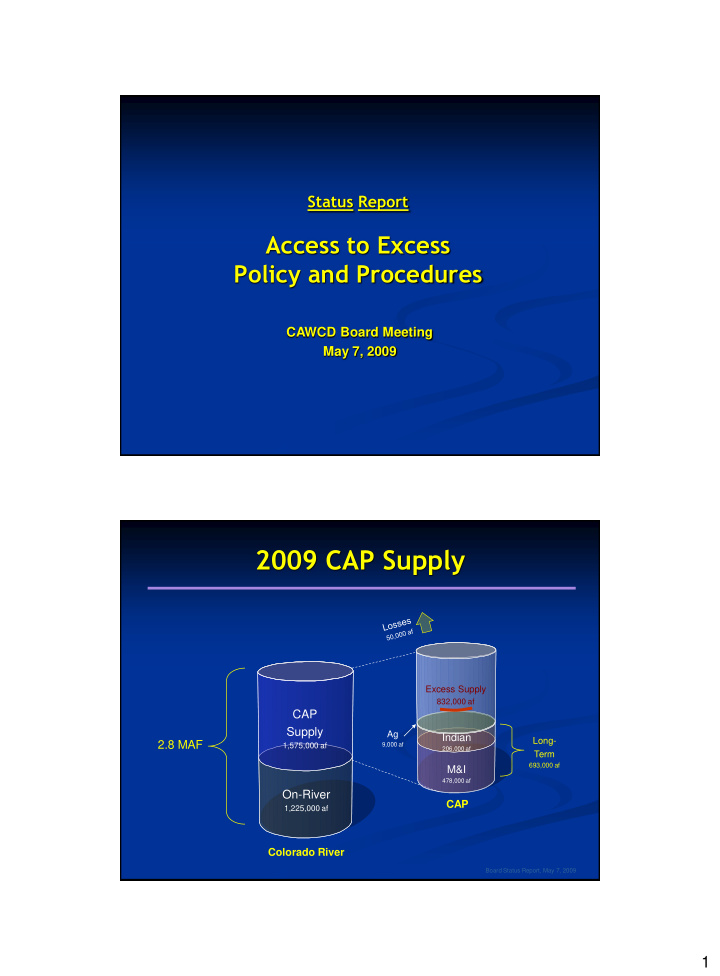



Status Report Access to Excess Policy and Procedures CAWCD Board Meeting May 7, 2009 2009 CAP Supply Excess Supply 832,000 af CAP Supply Ag Indian Long- 2.8 MAF 1,575,000 af 9,000 af 206,000 af Term 693,000 af M&I 478,000 af On-River CAP 1,225,000 af Colorado River Board Status Report, May 7, 2009 1
Early 1990s Excess Supply 2.8 MAF Indian CAP Ag Supply M&I On-River Colorado River Board Status Report, May 7, 2009 Early 1990s In response, CAP’s rates were restructured In lieu recharge program (GSFs) created Arizona Water Banking Authority (AWBA) created (1996) Board Status Report, May 7, 2009 2
AWBA Goal was to ensure that Arizona’s entire Colorado River Allocation was put to use by storing Excess CAP water Firm M&I subcontracts Firm Colorado River communities Use of Excess CAP water to Assist water management goals solve problems Enter into interstate banking Original “Access to Excess” allocation scheme: Fill all Excess CAP orders AWBA stores the rest Board Status Report, May 7, 2009 Ag Settlement Pool In exchange for contract relinquishment: Defined block of Excess CAP water through 2030 Highest priority of Excess 57,527 AF 32,537 AF 289,799 AF A critical component of the Phoenix AMA overall Arizona Water Settlements Act Pinal AMA 13,582 AF Use of Excess Use of Excess CAP water to Tucson CAP water to AMA solve problems solve problems Ag Settlement Pool Allocations Board Status Report, May 7, 2009 3
Interstate Banking Nevada was saber-rattling on Colorado River issues Banking offered mutual benefits, and was expected to be met with Excess CAP water Interstate banking program assisted with Lower Basin comity, including passage of Shortage Sharing agreement Use of Excess CAP water to solve problems Board Status Report, May 7, 2009 Indian Firming The “firmness” of a block of CAP water arose in Indian settlement discussions The State agreed that the AWBA would firm a portion of the Indian water The statutory obligation was expected to be met by storing excess CAP Use of Excess CAP water to solve problems Board Status Report, May 7, 2009 4
Replenishment Reserve Rapid growth of CAGRD heightened concerns about the lack of long-term supplies Statute was passed requiring a “cushion” of recharge credits Excess CAP was part of identified supply Use of Excess CAP water to solve problems Board Status Report, May 7, 2009 Customer Demand New and existing customers have increased their use of Excess, particularly Incentive Recharge To use directly To reduce future reliance on CAGRD To have supply for future projects To resell Use of Excess CAP water to solve problems Board Status Report, May 7, 2009 5
Not all of these demands have to be satisfied with Excess CAP water, but all put pressure on the supply There is still a large volume of Excess CAP water, and it can still be used to solve problems, but… There is a need for increased management of the supply A 2 E Process Objective of “Access to Excess” Process Policy guidance that can be turned into a program to manage the excess supply Potential Benefits Greater predictability for customers and staff Less annual conflict and jockeying among customers A more deliberate set of policy outcomes Consensus among stakeholders is preferred outcome Board Status Report, May 7, 2009 6
Recent Activity Two stakeholder workshops since last Board meeting More comment & discussion Original Staff proposal was not supported Staff explored elements of the AMWUA proposal that looked promising to build upon Separate pools “Self - determination” within pools A (shaky & grudging) consensus has developed around a revised Staff proposal Board Status Report, May 7, 2009 Revised Staff Proposal Applies for next 5 years Four separate pools Applies to remaining excess supply after fully satisfying Ag Pool Defined allocation formulas/methods within and among pools Board Status Report, May 7, 2009 7
AWBA & CAGRD RR Pool Fixed volume (175,000) for each of the next five years Would allow significant headway on remaining statutory goals and obligations for M&I, On-River and Indian firming Interstate is excluded CAGRD stays in compliance with statutory Replenishment Reserve requirements Allocation within pool is set as part of annual AWBA- CAWCD coordination and public meetings Board Status Report, May 7, 2009 CAGRD Pool For CAGRD annual replenishment obligation (not Reserve) Capped at 35,000 af/yr for the next five years Will require CAGRD to stay on-track for non-excess supply acquisitions Board Status Report, May 7, 2009 8
Remainder The remaining supply* is split evenly between two additional pools Municipal Pool for public & private water providers Industrial & Other Pool for everyone else Water not used by AWBA or CAGRD in either of their pools adds to these pools * (Total Excess – Ag Pool – AWBA/RR Pool – CAGRD Pool) Board Status Report, May 7, 2009 Municipal Pool Access within Muni pool incorporates two different approaches: historic use, and equal shares Historic Use Equal shares (“reserved”) (“unreserved”) Allocation Historic use factor diminishes through time Board Status Report, May 7, 2009 9
Industrial & Other Pool 30+ Customers 2009 Orders Future mines Credit remarketers Power plants Golf courses Nurseries Small Ag. Turf Ag Industrial SRP Remarketer Other Etc. Board Status Report, May 7, 2009 Industrial & Other Pool Pool is dominated by a handful of large customers (Resolution, Vidler, SRP, Rosemont, Aqua Capital) A proposal has been developed by largest stakeholders* Allocation based on historic use Credit remarketers are lowest priority within pool Small users are protected * Representatives of Resolution, Vidler, SRP & Rosemont Board Status Report, May 7, 2009 10
A 2 E Additional Steps Additional feedback from Board and Stakeholders Refinements General implementation issues Industrial & Other proposal Return for June Board meeting Board Status Report, May 7, 2009 Send comments & questions to Ken Seasholes (kseasholes@cap-az.com) 11
Recommend
More recommend